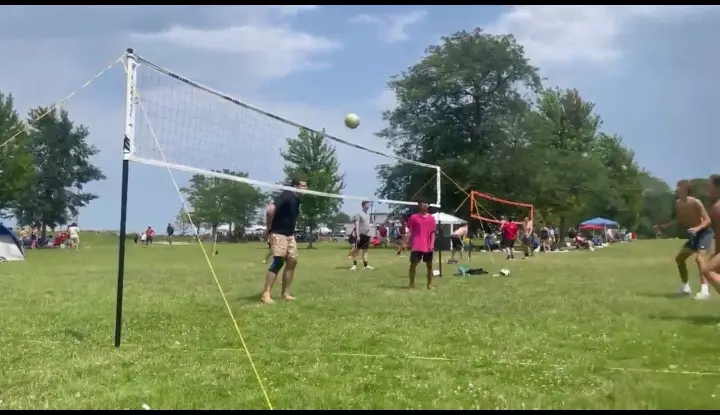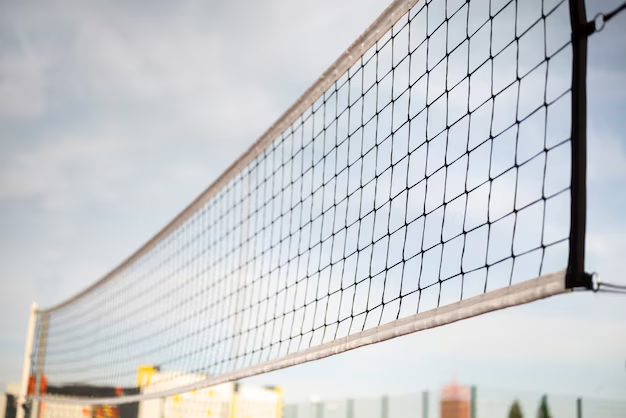Grass volleyball is an exciting, outdoor sport that brings together the competitiveness of indoor volleyball with the casual, laid-back outdoor sport.
As the name suggests, grass volleyball is traditionally played outdoors, on a grass field. However, it is also possible to do this indoors, since a special mobile system is used that can be installed both outdoors and in the hall.
This sport is governed by rules. There are numbers of Grass Volleyball Rules that players must abide to. Knowing the rules of grass volleyball is key to having a great time while keeping the game fair and fun.
In this guide, we’ll break down everything you need to know about grass volleyball, including the rules, setup, and tips for playing like a pro.
What is Grass Volleyball?
Grass volleyball is a variation of traditional volleyball played on grass instead of sand (beach volleyball) or a hardwood court (indoor volleyball). It’s a favorite for casual games at parks and competitive outdoor tournaments.
What makes grass volleyball unique is its flexibility—you can adjust team sizes, court dimensions, and rules to suit your skill level and number of players. It’s popular for both recreational play and organized competitions.
See Also:
- What is MB in volleyball? Volleyball position terms explained
- 4 Best Position in Volleyball
- Volleyball Hitting Drills
Grass Volleyball Rules

- The Players
- Each team must have a minimum of six active players.
- A team needs at least four players to avoid a forfeit.
- Failure to have four players five minutes after the game’s start results in losing the first set and, 15 minutes later, the second set (and the match).
- Uniform
- Casts are prohibited.
- Clothing with blood must be removed, and the player can return with clean attire.
- Substitution
- Two substitution options are available: the PE method (one in, one out) or the Buddy system.
- Substitutions must remain consistent throughout the set and must be notified to the referee before the set begins.
- Games and Scoring
- Matches consist of three sets: the first two sets to 25, win by two with a cap at 27, and the third set to 15, win by two with a cap at 17.
- Rally scoring is employed, where points are awarded for faults or successful plays.
- Play
- During the serve, receiving teams cannot spike or block but can set.
- The ball is live if it contacts the net and passes over.
- Players can legally use any body part to contact the ball, except below the knee.
- Each team has three contacts before passing the ball over the net.
- No prolonged contact or “possessing” the ball is allowed.
- Players may hit the ball off the net but cannot hit it into the net and immediately hit it again.
- Player Alignment
- Players must rotate clockwise, ensuring every player plays every position.
- Rotation of the serve is mandatory.
- Disputes
- Referees decide disputes after consulting team captains.
- Sportsmanship
- Zero-tolerance policy for behaviors like public drunkenness, violence, discrimination, and bullying.
- Captains are responsible for ensuring proper sportsmanlike behavior.
Ejected players must leave the park immediately
Grass Volleyball Court Setup
The court setup for grass volleyball is similar to that of a traditional volleyball court, but with a few key differences. The playing surface is, of course, a grassy area, which can vary in texture and evenness.
This natural surface adds an extra layer of challenge, requiring players to adapt their footwork and movements accordingly.
Court Dimensions
The dimensions of a grass volleyball court are typically smaller than those of an indoor court. A standard grass court measures approximately 16 meters (52 feet) in length and 8 meters (26 feet) in width. These dimensions may vary slightly depending on the tournament or league regulations.
Net Height

The net height for grass volleyball is typically lower than that of indoor volleyball. For men’s competitions, the net is typically set at 2.35 meters (7.7 feet), while for women’s competitions, it is set at 2.24 meters (7.3 feet). This lower net height compensates for the added difficulty of playing on grass and allows for more dynamic rallies.
Grass Volleyball Gameplay
While the fundamental rules of grass volleyball are similar to those of traditional volleyball, there are a few notable differences that players should be aware of.
Number of Players
Grass volleyball is typically played with teams of four players on each side of the court. However, variations may exist depending on the tournament or league regulations.
Serving Rules
In grass volleyball, the serve is executed from behind the baseline, just like in indoor volleyball. However, players must be mindful of the uneven surface, which can affect the trajectory and bounce of the serve.
Rallies and Scoring Rules
Rallies and scoring in grass volleyball follow the same rules as indoor volleyball. A team scores a point when the opposing team commits a fault or fails to return the ball legally. The first team to reach a predetermined score, typically 25 or 30 points, wins the set.
Rotations and Substitutions
Player rotations and substitutions in grass volleyball follow the same rules as indoor volleyball. Teams must rotate positions in a clockwise direction after winning the right to serve, and substitutions are allowed according to the established regulations.
Footwork and Movement
Proper footwork and movement are crucial on the grassy surface. Players should be prepared for uneven terrain and adjust their steps accordingly. Shorter, more controlled strides and a lower center of gravity can help maintain balance and agility.
Ball Control Rules
The grass surface can affect the bounce and trajectory of the ball, making ball control a significant challenge. Players should be prepared to adjust their positioning and anticipate irregular bounces, especially on serve reception and defensive plays.
Communication Rules
Effective communication between teammates is essential in grass volleyball. With the added challenges of the grassy surface, clear communication about ball placement, rotations, and defensive positioning can make a significant difference in the team’s performance.
Differences Between Grass and Indoor Volleyball
Below is a quick comparison to highlight how grass volleyball differs from the indoor version:
| Aspect | Grass Volleyball | Indoor Volleyball |
| Court Surface | Grass | Hardwood |
| Team Sizes | 2, 3, or 6 players | Always 6 players |
| Court Dimensions | Smaller for doubles/triples (52.5 x 26.25 feet) | Standard size (60 x 30 feet) |
| Net Height | Same as indoor | Same as grass |
| Player Movement | No fixed positions in doubles/triples | Players must rotate and maintain positions |
| Setting the Ball | Stricter on open-hand setting (no lifts or doubles) | More leniency in handling the ball |
| Weather Factor | Outdoor conditions (wind, uneven ground) | Controlled indoor environment |
Grass Volleyball Competitions
Grass volleyball has an official sports status, so it hosts annual tournaments, which are usually local or regional in nature.
They are carried out for the purpose of:
- Promoting a healthy lifestyle.
- Popularization of volleyball.
- Involving more people in active physical education and sports.
Men’s and women’s volleyball teams, as well as mixed ones (multiple players on the same team), participate in the competition. However, a mixed team always participates in the men’s tournament.
Competitions are held according to the rules of the game of grass volleyball. The winners are awarded diplomas, medals, and memorable prizes. A cup and monetary reward may also be awarded (at the discretion of the organizers).
Grass volleyball has not yet received worldwide recognition but has all the prospects for this since the International Volleyball Federation has recently been promoting it. Perhaps, over time, it will even be included in the official Olympic program.
FAQs
What is the maximum number of touches allowed per team in grass volleyball?
Like indoor volleyball, each team is allowed a maximum of three consecutive touches (in addition to blocking) before returning the ball over the net.
Can players use their hands to hit the ball in grass volleyball?
No, players are not allowed to use their hands to hit the ball in grass volleyball. The ball must be played using other legal body parts, such as the arms, shoulders, or feet.
Are there any specific rules regarding player attire in grass volleyball?
While there are no strict dress codes, players are generally advised to wear appropriate athletic attire that allows for freedom of movement and provides traction on the grassy surface. Cleats or shoes with good grip are recommended.
Can a player touch the net during play?
No, touching the net during play is considered a fault in grass volleyball, just as it is in indoor volleyball. Players must be careful not to make contact with the net while attempting to play the ball.
How is the serving order determined in grass volleyball?
The serving order in grass volleyball is typically determined by a coin toss or a similar method before the start of the match. The team that wins the toss or rally has the choice of serving first or choosing the side of the court.
See also:
- Beach Volleyball Rules 2024: Key Differences From Indoor Game
- Middle School Volleyball Rules (2024 Updated)
Final Take (Conclusion)
Grass volleyball is a unique and exciting variation of the traditional sport, offering players a chance to connect with nature while enjoying the thrill of competition.
By understanding the rules, strategies, and differences of grass volleyball, players can fully embrace the challenges and rewards of this outdoor adventure.



